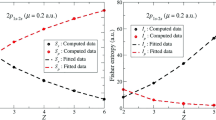Abstract
Using approximation of a uniform background (the jellium model) for a condensed dispersed phase, the analytical expressions describing a spatial distribution of the potential of the electric field and electron concentration in the low-temperature plasma at equilibrium which contains hollow spherical microparticles are obtained. The influence of heating temperature of plasma on the above distributions is studied, and the dependencies of the charge on microparticle radius, the size of the microparticle cavity and the absolute temperature of plasma are calculated. It is shown that electrons can be emitted not only into the surrounding plasma but also into the cavity of the particles.






Similar content being viewed by others
References
Artsimovich LA, Sagdeyev RZ (1979) Plasma physics for physicists. Atomizdat, Moscow
Ashcroft NW, Mermin ND (1976) Solid state physics. Saunders College, Philadelphia
Couedel L, Nosenko V, Ivlev AV, Zhdanov SK, Thomas HM, Morfill GE (2010) Direct observation of mode-coupling instability in two-dimensional plasma crystals. Phys Rev Lett 104:195001
D’yachkov LG, Khrapak AG, Khrapak SA (2008) Influence of electron emission on the charge and shielding of a microparticle in plasma in the regime of a continuous medium. Zh Éksp Teor Fiz 133:197–203
Dautov G, Fayrushin I, Kashapov N (2014) Influence of metal macroparticles to the electron density in a dusty plasma. J Phys: Conf Ser 567:012006
Delzanno GL, Tang XZ (2014) Charging and heat collection by a positively charged dust grain in a plasma. Phys Rev Lett 113:035002
Ekardt W (1984) Work function of small metal particles: self-consistent spherical jellium-background model. Phys Rev B 29:1558
Fairushin I, Dautov I, Shamsutdinov A (2014) Distribution of electric field near the surface of the aluminum oxide particle in the dust-electron thermal plasma. J Phys: Conf Ser 567:012007
Fomenko VS (1981) Emissivity of materials. Naukova dumka, Kiev
Fortov YV, Khrapak AG, Yakubov IT (2004) Physics of collisional plasma. Study guide. Fizmatlit, Moscow
Fortov VE, Petrov OF, Vaulina OS, Timirkhanov RA (2012) Viscosity of a strongly coupled dust component in a weakly ionized plasma. Phys Rev Lett 109:055002
Ivanov VK, Ipatov AN, Kharchenko VA (1996) Optimized ZHELE model for metal clusters with screen Coulomb interaction. Zh Éksp Teor Fiz 109:902–915
Khrapak SA, Morfill GE, Fortov VE, D’yachkov LG, Khrapak AG, Petrov OF (2007) Attraction of positively charged particles in highly collisional plasmas. Phys Rev Lett 99:055003
Krauz VI, Martynenko YV, Svechnikov NY, Smirnov VP, Stankevich VG, Khimchenko LN (2010) Nanostructures in controlled thermonuclear fusion devices. Phys Usp 53:1015–1038
Landau LD, Lifshits YM (2010) Theoretical physics, vol 5. Fizmatlit, Moscow
Ma H et al (2007) Nest‐like silicon nanospheres for high‐capacity lithium storage. Adv Mater 19:4067
Merlino RL (2005) Experimental investigations of dusty plasmas. AIP Conf Proc 799:3. doi:10.1063/1.2134567
Samarian AA, Vaulina OS, Nefedov AP, Fortov VE, James BW, Petrov OF (2001) Positively charged particles in dusty plasmas. Phys Rev E 64:056407
Selwyn GS, Heidenreich JE, Haller KL (1990) Particle trapping phenomena in radio frequency plasmas. Appl Phys Lett 57:1878
Shukla PK, Mamun AA (2002) Introduction to dusty plasma physics. IOP, Bristol
Smirnov MB, Krainov VP (1999) Multiple ionization of a Thomas-Fermi cluster by a strong electromagnetic field. Zh Éksp Teor Fiz 115:2014–2019
Smirnov RD, Pigarov AY, Rosenberg M, Krasheninnikov SI, Mendis DA (2007) Modelling of dynamics and transport of carbon dust particles in tokamaks. Plasma Phys Control Fusion 49:347
Smith BA et al (1982) A new look at the Saturn system: the Voyager 2 images. Science 215:504–537
Solonenko OP, Gulyaev IP, Smirnov AV (2011) Thermal plasma processes for production of hollow spherical powders: theory and experiment. J Thermal Sci Technol 6:219–234
Song YL, Huang F, Chen ZY, Liu YH, Yu MY (2016) Self-organization and oscillation of negatively charged dust particles in a 2-dimensional dusty plasma. Phys Lett A 380:886–895
Thomas E Jr (2009) Dust clouds in dc-generated dusty plasmas: transport, waves, and three-dimensional effects. Contrib Plasma Phys 49:316–345
Valderrama E, Favre M, Bhuyan H, Ruiz HM, Wyndham E, Valenzuela J, Chuaqui H (2010) Sub-micron size carbon structures synthesized using plasma enhanced CVD, without external heating and no catalyzer action. Surf Coat Technol 240:2940–2943
Vaverka J, Richterová I, Vyšinka M, Pavlü J, Šafránková J, Němeček Z (2014) The influence of secondary electron emission on the floating potential of tokamak-born dust. Plasma Phys Control Fusion 56:025001
Vishnyakov VI (2012) Charging of dust in thermal collisional plasmas. Phys Rev E 85:026402
Vishnyakov VI, Dragan GS (2006) Thermoemission (dust-electron) plasmas: theory of neutralizing charges. Phys Rev E 73:026403
Vishnyakov VI, Dragan GS, Evtuhov VM (2007) Nonlinear Poisson–Boltzmann equation in spherical symmetry. Phys Rev E 76:036402
Vladimirov SV, Ostrikov K, Samarian AA (2005) Physics and applications of complex plasmas. Imperial College Press, London
Zolotko AN, Vovchuk YI, Poletayev NI, Florko AV (1996) Synthesis of nanooxides in two-phase laminar flames. Phys Combust Explos 32:2
Acknowledgments
The work was performed within the framework of the Russian Government Program of Competitive Growth of Kazan Federal University.
Author information
Authors and Affiliations
Corresponding author
Rights and permissions
About this article
Cite this article
Fayrushin, I.I., Dautov, I.G. & Kashapov, N.F. Distribution of the potential and concentration of electrons in low-temperature plasma with hollow microparticles. Int. J. Environ. Sci. Technol. 14, 2555–2560 (2017). https://doi.org/10.1007/s13762-016-1054-8
Received:
Accepted:
Published:
Issue Date:
DOI: https://doi.org/10.1007/s13762-016-1054-8




